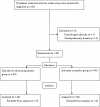Effect of electroacupuncture in postanesthetic shivering during regional anesthesia: a randomized controlled trial
- PMID: 23181618
- PMCID: PMC3526538
- DOI: 10.1186/1472-6882-12-233
Effect of electroacupuncture in postanesthetic shivering during regional anesthesia: a randomized controlled trial
Abstract
Background: Shivering during regional anesthesia is a common complication and is related to a decrease in the patient's core body temperature. Previous studies have shown that acupuncture on specific acupoints can preserve core body temperature. The present study evaluated the effect of electroacupuncture in preventing the shivering caused by regional anesthesia.
Methods: This prospective and randomized controlled study analyzed the data from 80 patients undergoing urological surgery, who were classified as ASA I or II. Spinal anesthesia was performed in all patients using 15 mg of bupivacaine. The patients were randomly allocated to receive either placebo acupuncture (Group P, n=40) or electroacupuncture (Group A, n=40) for 30 min before administration of spinal anesthesia. Shivering score was recorded at 5 min intervals, with 0 representing no shivering and 4 representing the most severe shivering possible. Heart rate, blood pressure, and tympanic temperature were recorded before the intrathecal injection, and again every 5 min thereafter until 30 min.
Results: After spinal anesthesia, the decrease in tympanic temperature was less for Group A patients than Group P, with the difference being statistically significant. After 15 min, 13 patients in Group P attained a shivering score of 3 or more, compared with 3 patients in Group A. Significantly more patients in Group P attained a shivering score of at least 1.
Conclusions: The prophylactic use of electroacupuncture might maintain core body temperature, and may effectively prevent the shivering that commonly develops during regional anesthesia.
Trial registration: Australian New Zealand Clinical Trials Registry ACTRN12612000096853.
Figures




Similar articles
-
Comparison of effect of electroacupuncture and nefopam for prevention of postanesthetic shivering in patients undergoing urologic operation under spinal anesthesia.Korean J Anesthesiol. 2016 Dec;69(6):579-586. doi: 10.4097/kjae.2016.69.6.579. Epub 2016 Oct 25. Korean J Anesthesiol. 2016. PMID: 27924198 Free PMC article.
-
A comparison of prophylactic use of meperidine, meperidine plus dexamethasone, and ketamine plus midazolam for preventing of shivering during spinal anesthesia: a randomized, double-blind, placebo-controlled study.J Clin Anesth. 2016 Nov;34:128-35. doi: 10.1016/j.jclinane.2016.03.036. Epub 2016 May 3. J Clin Anesth. 2016. PMID: 27687359 Clinical Trial.
-
Efficacy of forced-air warming and warmed intravenous fluid for prevention of hypothermia and shivering during caesarean delivery under spinal anaesthesia: A randomised controlled trial.Eur J Anaesthesiol. 2019 Jun;36(6):442-448. doi: 10.1097/EJA.0000000000000990. Eur J Anaesthesiol. 2019. PMID: 30985539 Clinical Trial.
-
Efficacy and safety of prophylactic use of ketamine for prevention of postanesthetic shivering: a systematic review and meta analysis.BMC Anesthesiol. 2019 Dec 30;19(1):245. doi: 10.1186/s12871-019-0910-8. BMC Anesthesiol. 2019. PMID: 31888509 Free PMC article.
-
Effect of 5-μg Dose of Dexmedetomidine in Combination With Intrathecal Bupivacaine on Spinal Anesthesia: A Systematic Review and Meta-analysis.Clin Ther. 2020 Apr;42(4):676-690.e5. doi: 10.1016/j.clinthera.2020.02.009. Epub 2020 Mar 25. Clin Ther. 2020. PMID: 32222361
Cited by
-
Sham Electroacupuncture Methods in Randomized Controlled Trials.Sci Rep. 2017 Jan 20;7:40837. doi: 10.1038/srep40837. Sci Rep. 2017. PMID: 28106094 Free PMC article.
-
Comparison of effect of electroacupuncture and nefopam for prevention of postanesthetic shivering in patients undergoing urologic operation under spinal anesthesia.Korean J Anesthesiol. 2016 Dec;69(6):579-586. doi: 10.4097/kjae.2016.69.6.579. Epub 2016 Oct 25. Korean J Anesthesiol. 2016. PMID: 27924198 Free PMC article.
References
Publication types
MeSH terms
Substances
LinkOut - more resources
Full Text Sources

